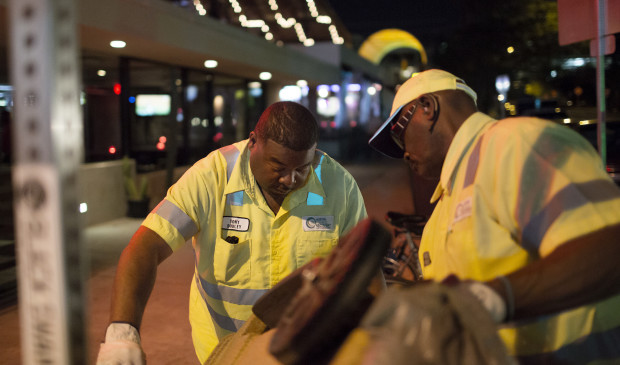How the city handles SXSW cleanup
Thursday, March 17, 2016 by
Audrey McGlinchy, KUT On Sixth Street just past midnight, small herds of young people mill in the street or near the entrances of bars – some smoking cigarettes, others looking at their phones. Virginia Alexander honks at them to move. She is trying to drive her ATV down the street to get to the trash cans.
“Watch out, baby!” she yells at a young man who almost walks into her vehicle.
Alexander oversees a litter control crew with Austin Resource Recovery, the city’s trash department. She stops at a cluster of food trucks on Red River Street. Alexander hops out of the ATV, a roll of dark gray trash bags in hand. She mouths the cleanup routine to herself: “Pull out the cans, emptying out the cans.”
Last year, South by Southwest generated roughly 257,000 pounds of trash. The city of Austin spent $142,565 (including staff and equipment costs) to clean up each night of the festival. In addition to the permanent trash bins, the city puts out about 200 temporary bins, hoping to ensure that revelers throw their garbage in a can. That is something they have control over, whereas stench is another story.
“There’s definitely an odor rise with South by Southwest,” says Amy Slagle, an assistant manager with Austin Resource Recovery’s litter abatement division. “There are a lot of companies that come in and they hand out free energy drinks, and so that definitely carries a stench after a while as well as just stale beer.”
These smells greet Alexander and her co-worker, Lawrence Martin, as they peer into cans along Red River Street. Once they decide whether the can is full enough to warrant replacing the bag, the full bags get thrown on the grass between the street and the sidewalk. These bags get chucked into the bed of the ATV.
Martin rattles off the offerings on tonight’s menu of rubbish: “Boxes, bottles, cans, paper. Mostly around the food court, you have the Styrofoam stuff – forks and spoons and stuff like that. Sometimes they don’t hardly eat part of the food,” he says.
The ATV’s bed is nearly full, so Alexander drives to Brushy and Sixth streets to unload. There sit two Tonka trunks – in other words, large trash compactors. Alexander and Martin throw the bags into the back, and then Martin turns the compactor on. Alexander steps back, warning about spraying liquids: “All the juice pushing out on you,” she says.
When asked if she’s ever gotten wet trash on her while standing too close to the compactor, she nods her head yes. “That’s nasty,” she says.
Alexander and Martin drive away from Brushy Street, toward the underpass at Sixth Street and I-35. Alexander grabs more dark gray trash bags from the supply truck parked there. On a regular day, she unloads full garbage bags into the Tonka trucks about every six hours. Not so during SXSW.
“We’ve been going every hour,” she says, “to keep the trash from flowing over.” At 1:30 a.m. Alexander and Martin begin to wind down their shift as another crew takes over. This one is led by Michael Womack, who supervises the morning shift beginning at 2:30 a.m.
Since most bars close at 2 a.m., workers on this shift no longer deal with emptying street cans. Instead, they use blowers to clear litter from the sidewalk while others operate street cleaner vehicles.
“The blower will blow the litter out into the street,” explains Womack. “The brooms will catch the litter and push it up underneath the vacuum, so it sweeps it up, or sucks it up. So it’s just a like a really big vacuum with brooms on the side.”
During the festival, these blowers and sweepers handle a large volume of waste.
“Let’s say a semi-automated trash truck that goes house to house, that’s about 800 to 1,000 houses that they do a day,” says Womack. During SXSW, they will have to clear that much trash in roughly three hours (from 3 a.m. to 6 a.m., when businesspeople start hitting the streets).
Womack works this shift year-round, and over the years he has devised some theories about nighttime in Austin. He said that each day, the city offers just 30 minutes of silence – between 3:30 a.m. and 4 a.m. He breaks down the kinds of people who are out before and after this short respite from noise.
“You have the partiers, then you have the partier stragglers,” he says. Then, 4 a.m. hits. “Then you have the construction workers, then you have the joggers, the dog walkers and all that stuff.”
After Womack finishes his shift at 1 p.m., Alexander and Martin take over at 3 p.m. Both say they have seen the increasing volume of trash each year testify to the festival’s ballooning number of attendees.
“Every year it gets bigger and bigger,” says Alexander, as she wrestles a trash bag half-full of food scraps and plastic out of the bin.
This story was produced as part of the Austin Monitor’s reporting partnership with KUT.
Update: The audio from McGlinchy’s radio story is posted below.
Audio Player
Tony Dudley Sr. and Steven Davis collect waste from a trash can at the corner of Fifth and Nueces streets during SXSW. Photo by Miguel Gutierrez Jr./KUT News.
You're a community leader
And we’re honored you look to us for serious, in-depth news. You know a strong community needs local and dedicated watchdog reporting. We’re here for you and that won’t change. Now will you take the powerful next step and support our nonprofit news organization?






